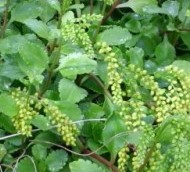 Native to limestone outcroppings in shady mountin areas of the Caucasus, this rhizomateous perennial succulent slowly grows to form a low mound of large fleshy ovate leaves with scalloped edges. Upright racemes of dangling pea-like flowers emerge well above the foliage in spring and early summer. The plants are suitable for shade gardens and rock gardens, and are especially attractive when growing in walls or between flagstones. They are also good edgers and mix well with other plants in containers. The genus name, Chiastophyllum, comes from the Greek words chiastros, meaning arranged diagonally, crosswise and phyllon, meaning leaf, and refers to the paris of opposite leaves. The specific epithet, oppositifolium, comes from the Latin words oppositus meaning opposite, and folium, meaning leaf, again referring to the position of the leaves. Lamb’s tail is a member of the stonewort family, Crassulaceae, that also includes jade plant, Kalanchoe, and hens and chickens.
Native to limestone outcroppings in shady mountin areas of the Caucasus, this rhizomateous perennial succulent slowly grows to form a low mound of large fleshy ovate leaves with scalloped edges. Upright racemes of dangling pea-like flowers emerge well above the foliage in spring and early summer. The plants are suitable for shade gardens and rock gardens, and are especially attractive when growing in walls or between flagstones. They are also good edgers and mix well with other plants in containers. The genus name, Chiastophyllum, comes from the Greek words chiastros, meaning arranged diagonally, crosswise and phyllon, meaning leaf, and refers to the paris of opposite leaves. The specific epithet, oppositifolium, comes from the Latin words oppositus meaning opposite, and folium, meaning leaf, again referring to the position of the leaves. Lamb’s tail is a member of the stonewort family, Crassulaceae, that also includes jade plant, Kalanchoe, and hens and chickens.
Type: Herbaceous perennial
Bloom: Racemes of small yellow dangling pea-like flowers in spring
Size: 6-8” H x 6-12” W
Light: Partial shade (needs afternoon shade in southern part of its range)
Soil: Poor to moderately fertile, moist, well-drained
Hardiness: Zones 5-9
Care: Low maintenance
Pests and Diseases: Snails and slugs may be a problem
Propagation: Seed but division in spring or fall easier
Companion plants: Purple leave Heuchera, ajuga, primroses, alpine columbine, candytuft